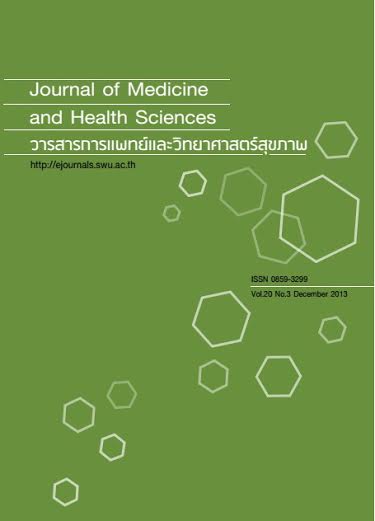Factors Influence the level of urinary mercury among dental staffs exposed to amalgam in community hospitals, Chanthaburi province
Keywords:
การสัมผัสเหตุอาชีพ, ปรอท, อะมัลกัม, Occupational exposure, Mercury, AmalgamAbstract
The objective of this study was to find factors influencing urinary mercury levels among dental staff who were exposed to amalgam in community hospitals of Chanthaburi Province. The study group consisted of 62 subjects, including dentists, dental nurses and dental assistants, with the control groups comprising 21 staff members from the Department of Medical Records. These subjects were from 11 Provincial community hospitals. Data were gathered using questionnaires. Personal air samples of mercury vapor were collected according to the standard of the NIOSH method 6009 and the levels of urinary mercury were also measured in all subjects. Data were analyzed by One-way ANOVA, Independent t-test and Pearson’s Correlation. The result showed that for the study group, 87.10 % were females and 12.90 % were males, with the average age of 33.99 ± 9.11 years. The average time they have been working was 9.40 ± 8.20 years and the average working hours were 10.74 ± 2.15 hours per day. The average levels of mercury exposure in the urine of the study and control groups were 3.60 ± 6.71 μg/g Creatinine and 1.82 ± 2.38 μg/g Creatinine, respectively. The average levels of mercury in the air for the study and control groups were 0.73 ± 0.35 μg/m3 and 0.10 ± 0.16 μg/m3, respectively. In comparing the levels of mercury in the urine between the study and control groups, there was no significant difference, but among study group participants with different positions of work, there were significant (p < 0.05). The mercury exposure in the air between the study group and the control group was significantly different (p < 0.001). In addition, the correlation between factors affecting airborne mercury exposure (working time, working hours per day, and mercury knowledge) and the level of mercury in the urine of the study group showed a positive correlation with the amount of mercury exposure in air with a statistical significance at 0.05 (p = 0.04, r = 0.25). However, there was no correlation between other factors. From this study, it is recommended that dental staffs are at risk of mercury exposure more than other health care workers. Therefore, they should undergo urinary mercury level monitoring, annually. Moreover, the level of mercury in the air should be examined annually as well as establishing standardized engineering management to control mercury vapors.
ปัจจัยที่ส่งผลต่อปริมาณสารปรอทในปัสสาวะ ของผู้ปฏิบัติงานทันตกรรมที่สัมผัสอะมัลกัม ในโรงพยาบาลชุมชน จังหวัดจันทบุรี
การศึกษาครั้งนี้มีวัตถุประสงค์เพื่อศึกษาปัจจัยที่ส่งผลกับปริมาณสารปรอทในปัสสาวะของผู้ปฏิบัติงาน ทันตกรรมที่สัมผัสอะมัลกัมในโรงพยาบาลชุมชน จังหวัดจันทบุรีกลุ่มที่ศึกษาประกอบด้วยผู้ปฏิบัติงานทันตกรรม ได้แก่ ทันตแพทย์ ทันตาภิบาล ผู้ช่วยทันตกรรม จำนวน 62 คน และกลุ่มควบคุมคือ เจ้าหน้าที่ที่ปฏิบัติงานในแผนกเวชระเบียน จำนวน 21 คน สังกัดโรงพยาบาลชุมชน จำนวน 11 แห่ง รวบรวมข้อมูลโดยใช้แบบสอบถาม เก็บตัวอย่างไอระเหยของปรอท ในอากาศตามมาตรฐานของ NIOSH Method 6009 และเก็บตัวอย่างปรอทในปัสสาวะของตัวอย่างทุกราย วิเคราะห์ โดยใช้สถิติ One-way ANOVA, Independent t-test และ Pearson’s Correlation ผลการศึกษาพบว่า กลุ่มที่ศึกษา เป็นเพศหญิงร้อยละ87.10เพศชายร้อยละ12.90มีอายุเฉลี่ย33.99 ± 9.11 ปีอายุงานเฉลี่ย9.40 ± 8.20 ปีชั่วโมงการทำงาน เฉลี่ย10.74 ± 2.16ชั่วโมงต่อวัน ปริมาณสารปรอทในปัสสาวะของกลุ่มศึกษาและกลุ่มควบคุมมีค่าเฉลี่ยเท่ากับ 3.60 ± 6.71 ไมโครกรัม/กรัม ครีตินิน และ 1.82 ± 2.38 ไมโครกรัม/กรัม ครีตินิน ตามลำดับ ปริมาณการรับสัมผัสสารปรอทในอากาศ ของกลุ่มศึกษาและกลุ่มควบคุม มีค่าเฉลี่ยเท่ากับ 0.73 ± 0.35 ไมโครกรัม/ลูกบาศก์เมตร และ 0.10 ± 0.16 ไมโครกรัม/ ลูกบาศก์เมตร ตามลำดับ จากการเปรียบเทียบเพื่อหาความแตกต่าง พบว่าผู้ปฏิบัติงานทันตกรรมมีปริมาณสารปรอท ในปัสสาวะไม่แตกต่างจากกลุ่มควบคุม แต่ในกลุ่มผู้ปฏิบัติงานทันตกรรมกับตำแหน่งงาน มีความแตกต่างกันอย่างมีนัยสำคัญทางสถิติ (p < 0.05) ส่วนปริมาณการรับสัมผัสสารปรอทในอากาศของกลุ่มศึกษาและกลุ่มควบคุมมีความแตกต่างกัน อย่างมีนัยสำคัญทางสถิติ (p < 0.001) นอกจากนี้การศึกษาความสัมพันธ์ระหว่างปัจจัยการรับสัมผัสสารปรอทในอากาศ อายุงาน ชั่วโมงการทำงานต่อวัน และความรู้เกี่ยวกับปรอท กับปริมาณสารปรอทในปัสสาวะของกลุ่มศึกษาพบว่า ปริมาณ สารปรอทในปัสสาวะ มีความสัมพันธ์ทางบวกกับปริมาณการรับสัมผัสสารปรอทในอากาศอย่างมีนัยสำคัญทางสถิติ (p = 0.04, r = 0.25) ส่วนปัจจัยอื่นๆ ไม่มีความสัมพันธ์กัน ข้อเสนอแนะจากการวิจัยในครั้งนี้คือ เจ้าหน้าที่แผนก ทันตกรรมมีความเสี่ยงต่อการสัมผัสสารปรอทมากกว่าบุคลากรทางการแพทย์กลุ่มอื่นๆ ดังนั้น ควรมีการตรวจสุขภาพ เพื่อหาปริมาณสารปรอทในปัสสาวะทุกปีร่วมกับการตรวจวัดปรอทในอากาศทุกปีและมีการบริหารจัดการด้านวิศวกรรมที่ แหล่งกำเนิดของไอปรอทให้ได้มาตรฐาน



